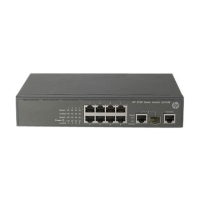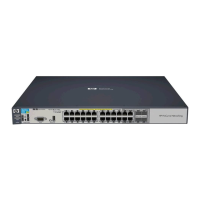42
Step Command Remarks
2. Create an ISP domain and
enter ISP domain view.
domain isp-name N/A
3. Return to system view.
quit N/A
4. Specify the default ISP
domain.
domain default enable
isp-name
Optional.
By default, the default ISP domain is the
system-defined ISP domain system.
NOTE:
To delete the ISP domain that is functioning as the default ISP domain, you must change it to a non-defaul
ISP domain by using the undo domain default
enable command.
Configuring ISP domain attributes
In an ISP domain, you can configure the following attributes:
• Domain status—By placing the ISP domain to the active or blocked state, you allow or deny
network service requests from users in the domain.
• Maximum number of online users—The switch controls the number of online users in a domain to
ensure the system performance and service reliability.
• Idle cut—This function enables the switch to check the traffic of each online user in the domain at the
idle timeout interval, and to log out any user in the domain whose traffic during the idle timeout
period is less than the specified minimum traffic.
• Self-service server location—By using the information defined in this attribute, users can access the
self-service server to manage their own accounts and passwords. A self-service RADIUS server, such
as IMC, is required for the self-service server location function to work.
• Default authorization user profile—If a user passes authentication but is authorized with no user
profile, the switch authorizes the default user profile of the ISP domain to the user and restricts the
user's behavior based on the profile. For more information about user profiles, see "Configuring a
use
r profile."
• DSCP value—The switch sets the specified DSCP value in IP packets from authenticated users in the
ISP domain, which is identified in the login username userid@domain-name. Policy-based routing
routes IP packets to different destinations based on the DSCP value. This attribute applies only to ISP
domains that use the same scheme for Layer 3 portal authentication. For more information about
policy-based routing, see Layer 3—IP Routing Configuration Guide. For more information about
Layer 3 portal authentication, see "Configuring portal authentication."
To configure ISP domain attributes:
Step Command Remarks
1. Enter system view.
system-view N/A
2. Enter ISP domain view.
domain isp-name N/A
3. Place the ISP domain to the
state of active or blocked.
state { active | block }
Optional.
By default, an ISP domain is in active
state, and users in the domain can
request network services.
